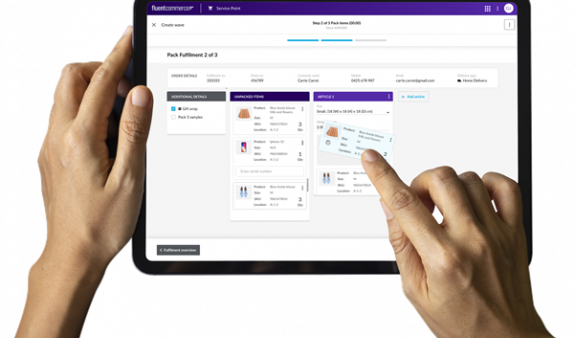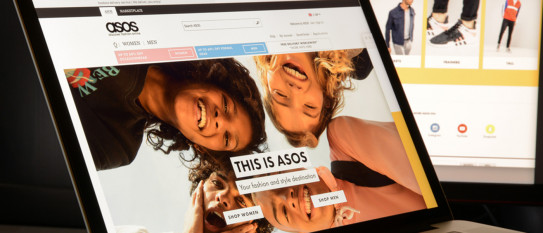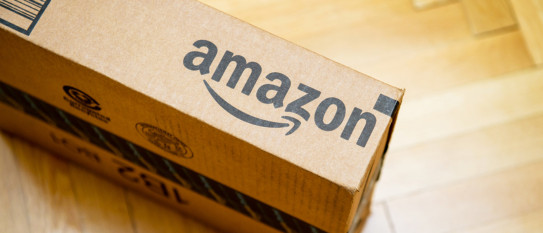
The benefits OMS can have on customer loyalty and your omnichannel strategy
What is an order management system?
Selling effectively is every ecommerce business's greatest challenge. Without an order management system (OMS), an online seller can quickly become overwhelmed with orders and be unable to effectively manage and meet customer expectations.
An OMS allows for seamless fulfilment, management and processing of orders in one place, meaning that your business can reduce product flow flaws and ensure a consistent customer experience which in turn, will support in building confidence and loyalty in your brand.
Incorporating everything from order processing to customer services, management of inventory and warehouse operations, OMS brings together orders placed and inventory available across all channels into a single view. This approach offers a joined-up solution that ensures all components of the business are able to effectively communicate with one another, which, in turn ensures an aligned customer message and experience is upheld across the board whilst supporting the brand in delivering a truly omnichannel experience.
The elements of OMS
Orders processed through an order management system ensure continuity within communication between customers and businesses, alongside communication within the business between different departments. An integrated system will typically encompass modules, including;
- Product information including detailed descriptions, location in warehouses, size and weight, quantities, and attributes
- Available inventory to promise (ATP) and sourcing information
- Details of vendors, receiving and purchasing
- Marketing and communication materials such as promotions and pricing
- Customer details
- Refund and returns processes
- Order entry and customer service information
- Financial processing details such as billing, payments due, credit card details
- Order processing including selection, packing, printing and shipping
Order management systems are absolutely crucial for ecommerce retailers but are also often integrated into businesses in other sectors, such as telecommunications, pharmaceuticals, healthcare, automotive and financial services.
Customer needs are constantly evolving and changing, and as a result, brands need to be equally as flexible to ensure they can provide the most convenient way to shop. Brands need to implement processes which allow them to react to orders quickly, with as few errors as possible resulting in reduced delays.

The importance of an order management system
Today, 91% of consumers expect an ETA for their order, with 86% wanting to buy online and return to store. This means one thing is clear for all retailers looking to build loyalty - choice is everything to the consumer of 2018. This multi-channel approach can very quickly spiral out of control without the use of a succinct OMS to help retailers to manage this ever more fluid process of ordering, buying, tracking and returning.
Primarily, investing in an OMS allows a retailer to truly adopt a succinct omnichannel approach - a crucial consideration for almost any growth focussed ecommerce strategy. Incorporating fulfilment models such as endless aisle, click & collect, reserve & collect and ship from store, (all whilst tracking inventory) should they choose to, order management systems give retailers endless opportunities to adapt to consumer demand and even expand into new channels.
In short, order management systems can:
- Increase sales
- Improve inventory velocity
- Bring together orders placed across all channels into a single view
- Provides a single view of all inventory across all inventory channels
- Provide a customer service portal to manage
- Be configurable to meet specific business rules, defining the experience you want to give customers
- Enable the creation of omni-channel shopping experiences like endless aisle, click and collect, reserve and collect, ship from store
- Ensures inventory is surfaced in the channel the customer wants to shop in
- Ensures order is fulfilled in the manner that the customers chooses
Building brand trust
An enhanced end-to-end purchasing experience is recognised as building an increased amount of trust in the brand. Customers put a great amount of value on their capability to purchase, exchange or return a product easily and from the comfort of their own home, at their convenience. Improving the customer experience through the implementation of OMS means that customer service costs can be reduced dramatically, and the process can be expedited for a quicker turnaround.
Moreover, supply chains can be more effectively monitored through the use of OMS, helping retailers build better, smarter and more transparent systems which will increase reliability and build trust in their brand. Brands not only have to demonstrate that they are reliable but also that they need to build loyalty within their consumer community, to back-up this claim.
With a large portion of the customer base refusing to put their trust into what a brand ‘claims to do’, they will often take to social media platforms to gain a more informed decision on the companies operations, quality and claims. Customers place trust in the existing consumer-base to review and inform them about the service they should expect to receive throughout the whole process, from browsing on different platforms to delivery-times and refund processes. So, maintaining a certain quality of service will be reflected in what people say about your brand online, whether it’s good or bad initially, it’s highly influential.
Easy returns
With impulse buying increasing in popularity, brands need to be prepared for a higher number of returns. The ease of returning a product needs to be as simple as buying, without it costing the buyer more to send back or requiring them to have any additional resources to do so, including printers or extra packaging.
Those with physical stores need to ensure an effective OMS is in place to allow users to purchase online, opt for home delivery or store collection and be able to create returns easily, whether this is through a drop off service, a collection from their home or office or returning in store. For retailers who exist entirely online, they need to ensure an easy process when it comes to delivery and returns, which should include offering the option to deliver or collect from a nearby convenience store or similar, where home deliveries are not possible and likewise for returning items. Ensuring there is plenty of time to allow customers to make these decisions is key for online retailers, too shorter time will result in unhappy customers who have had to make snap-decisions to meet your stringent deadlines.

More and more retailers, with apparel being one of the key sectors, are offering the option to purchase next day delivery for a year. This service typically amounts to the cost of around two to three individual next day deliveries (when purchased separately), with major retailers such as ASOS offering the option for only £9.99. The service, which is often offered at a relatively cheap cost to the customers, can drive brand loyalty, due to the knowledge that the order will arrive within 24 hours, and seemingly has ‘free’ delivery once the service has been purchased. Delivery cost can sway the consumer purchasing decision massively, especially if an order is first confined to a wishlist, placing an order may hinge entirely on the cost and turnaround of the service, something ‘free next day delivery’ can quickly eradicate. Those who have already committed to a year's delivery will ultimately want to get the most for their money, even if what that retailer is offering is more expensive or slightly different to the desired purchase.
Omnichannel champions: Amazon
Amazon is one of the clear champions of the omnichannel world, offering an almost ironclad approach to shopping. Customers can find almost anything on their platform, which is also hosted on a seamless mobile app. Easy transactions, including one-click buying, inspire impulse and easy purchases alongside the implementation of ‘buttons’; a physical button to stick in a convenient location in the home, which can be pressed to place an order, instantly, when a customer runs out of their regular products.
Right down to the customer service approach, Amazon has considered the best way to retain their consumers. When problems, delays or cancellations occur, these are communicated through emails and push notifications, straight to the user. When customers are dissatisfied with the service or have a complaint, an online chat option is available making it easier than ever for users to speak to a member of the customer service team. Escalation is also seamless and offers customers free callback options and the ability to take their complaint as far as they wish, with Amazon typically refunding a portion or all of the purchase value or offering services such as free Amazon Prime for a certain amount of time, in order to ensure that every customer feels valued.
An OMS provides the solution to meet any customer need and allows retailers to compete with brand giants such as Amazon when delivering their omnichannel strategy.

OMS & omnichannel champions: Screwfix
A model brand within both its parent company and the industry, Screwfix is another retail giant who has consistently focussed on ease of customer experience and designed a seamless order management system to cater to their ongoing demand. In just the first half of the financial year alone, Screwfix saw sales of £802m, 10.4% ahead of those projected and digital sales up by 18%.
A mobile first focus put mobile sales up by 43% and click and collect sales up by 21%, with the retailer focusing on usability and ease of orders for their customers. With a large portion of the customer base working largely in trades, the ease of browsing and purchasing using their mobile phones whilst on the go or at a job make perfect sense for Screwfix. Maintaining the mobile app and mobile website to ensure that it meets the needs of tradespeople, with a wide range of technical capabilities, was crucial to ensuring that the products can be easily found, purchased and collected or delivered to fit around their varied working hours.
With an IT system considered ‘best-in-class’ by the parent company, Kingfisher Group, Screwfix was able to build a core ecommerce platform which integrates an intelligent site search, seamless checkout function and a range of mobile sites to suit all popular operating systems. Around half of Kingfisher Group sales take place through this unified system, following a wider rollout after significant conversions were seen following initial implementation and further content development planned for the future to improve the overall customer experience.
Furthermore, Screwfix and sister-company; B&Q, who focuses on targeting different audiences within the same sector, take different approaches to provide the best experience for their customers. Where Screwfix trade customers typically already have the know-how, they are targeted with tools, equipment and supplies. The brand implemented in-store specialist trade desks, designed for plumbers, electricians and handymen, which has been attributed as one of the key drivers behind their significant sales growth.
On the reverse-side, B&Q customers are typically more DIY focussed and as a result, often have a less comprehensive knowledge of what they may need to complete a job. Because of this, B&Q have implemented multiple tools and content to support their customer base in getting the job done, including the launch of a Bathroom Planner tool at the tail end of 2017 which saw 148,000 people interact with the asset and an extensive blog which details how to complete a range of home DIY jobs including video.

Key takeaways
For retailers big and small, taking a leaf out of Amazon and Screwfix’s book may not be as extreme as an attempt to match the online giant in service or capabilities. An OMS provides the solution to meet this customer need and allows retailers to compete - no matter their size. However, it does present the question of what more can your brand do for your customers to ensure that regardless of problems, you live up to your promises? If your omnichannel retail strategy is backed up by a comprehensive OMS and considers every touch point of the customer journey, you’ll be better able to meet the expectations of your customers and ensure that even when dissatisfied, there is always a way to entice that customer back to your store.
- Customers demand an experience tailored to their needs and are prioritising convenience based on many of the factors outlined above. Know your customers, understand how they shop and want to receive their goods.
- Ensure that the browsing and buying experience aligns with customer knowledge and background
- Be consistent across all platforms, ensuring that customers can access the brand in the way most suited to their lifestyle whilst receiving aligned messaging and service
Barry Thorn is the Business Director at Redbox Digital, responsible for commercial strategy and development. He has worked in ecommerce for more than 15 years, having previously run the retail go-to-market for KPMG’s MSFT Dynamics and Magento practices. His focus in on the transformative impact of digital, eCommerce, cloud, ERP and CRM technologies, and supporting retailers with their digital and omnichannel ambitions. To get in touch and start a conversation, feel free to email [email protected]